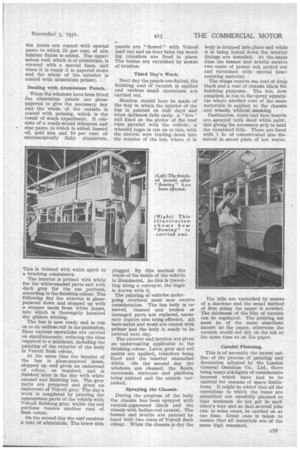Scientific Methods in
Page 152

Page 153

If you've noticed an error in this article please click here to report it so we can fix it.
Bus PAINTING ALITIOUGEI the painting of the buses owned by the London General Omnibus Co., Ltd., 55, Broadway, S.W.1, may seem to be a commonplace operation, behind it lies an interesting story of progress and achievement both in the methods and materials employed.
At first, in the days of horsed buses various routes were indicated by the colouring of the vehicles covering them, but standardization became necessary, and red and grey were the colours adopted. The former is durable and attractive, and the latter does not readily show the deposit of London's fog and soot.
In 1915 the first spray-painting plant was installed, and in 1919 tests were carried out with " flow " painting. The method adopted in the latter case was crude, the bus wings being treated with paint poured from a four-gallon can having a nozzle similar to that of a vacuum cleaner. The surplus material drained into drip pans.
This system was extended to bonnets and panels, and was found e18 to be successful. The success of " flowing " depends upon the correct consistency and viscosity of the material, and the pigment must be one that keeps in continuous and uniform suspension.
In 1926 the London General Omnibus Co., Ltd., commenced experiments with cellulose, but it found that the material was not suitable for use on the large surfaces of a bus body, although cellulose lacquers and enamels can be advantageously employed in connection with fittings, which are now thus treated. The cellulose is sprayed, but this method has been found not to be progressive when applied to a bus body as a whole.
To-day the process of painting begins after structural parts have been milled and cleaned up, when they are dipped into a bath of waterproofing and preserving solution and dried for 24 hours at a temperature of 60 degrees F. Other parts, such as floorboards, staircase treads and risers, etc., are sprayed with priming material.
Metalwork, other than aluminium, is cleaned with white spirit and dipped into metal primer. When these parts are fitted to a new body
This is thinned with white spirit to a brushing consistency.
The interior is primed with white for the white-enamel parts and with dark grey for the tan portions, according to the finishing colour. The following day the exterior is glasspapered down and stopped up with a stopper made from white japan, into which is thoroughly kneaded dry gilders whiting.
The bus is now ready and is run on to an endless rail in the paintshop. Here various operations are carried on simultaneously, reducing the timerequired to a minimum, including the painting of the exterior of the body in Vulcoil flesh colour.
At the same time the interior of the bus is glass-papered down, stopped up and given an undercoat of colour, as required, and is finished later in the day with white enamel and finishing tan. The grey parts are prepared and given an undercoat of Vulcoil grey. The day's work is completed by painting the appropriate parts of the vehicle with Vulcoil finishing grey, whilst the red portions receive another coat of flesh colour.
On the second day the roof receives a coat of aluminium. The lower side plugged By this method the whole of the inside of the vehicle is illuminated. As this is travelling along a conveyor, the bogie is drawn with it.
The painting of vehicles undergoing overhaul must now receive consideration. The bus body is removed, cleaned and broken or damaged parts are replaced, necessary repairs also being effected. All bare metal and wood are coated with primer and the body is ready to be painted next day.
The exterior and interior are given an undercoating applicable to the finishing colour. Later, grey and red paints are applied, transfers being -fixed and the interior enamelled white. On the second day the windows are cleaned, the floors, surrounds, staircase and platform being painted and the outside varnished.
Spraying the Chassis.
During the progress of the body the chassis has been sprayed with varnish-pigmented black and the wheels with Indian-red varnish. The bonnet and scuttle are painted by hand with two coats of Vulcoil flesh cblour. When the chassis is dry the The bills are varnished by means of a machine and the usual method of first sizing the paper is avoided. The thickness of the film of varnish can be regulated. The printing ink must be of the same absorbent nature as the paper, otherwise the varnish would not dry on the ink at the same time as on the paper.
Careful Planning.
This is of necessity the barest outline of the process of painting and decoration adopted by the London General Omnibus Co., Ltd., there being many sidelights of considerable interest which have had to be omitted for reasons of space limitations. It might be added that all the operations to which the buses are submitted are carefully planned so that workmen do not get in each other's way and so that_several jobs can, in some eases, be carried on at one time. Great care is taken to ensure that all materials are of the same high standard.








































































































































































































































